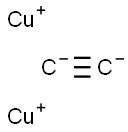amorphous red powder(s); unstable; oxidizes in air to Cu2O, carbon, and water, structure CuC≡CCu; can explode when subjected to shock or heated; obtained by reacting acetylene, HC≡CH, with soluble cuprous salt in water; used in detonators and other explosives [HAW93] [KIR78]
Red amorphous powder; explodes on heating; insoluble in water; soluble in acids.
Cuprous acetylide is used as a diagnostic testto identify the ≡CH unit; to purify acetylene;in the preparation of pure copper powder;and as a catalyst in the manufacture of 2-propyn-1-ol and acrylonitrile.
Copper(I) acetylide is prepared by passing acetylene gas over an aqueous solution of ammoniacal copper saltHCCH + 2Cu(NH3)2OH → CuCCCu + 4NH3 + 2H2O.
There are no toxicity data in the published literatureon cuprous acetylide. As with manycopper salts, inhalation of its dust can causeirritation of the respiratory tract and ulcerationof nasal septum.
Cuprous acetylide in the dry state is highly
sensitive to shock, causing explosion on
impact. It explodes in contact with acetylene
after being warmed in air or oxygen for several
hours (Mellor 1946). It forms a highly
explosive mixture containing silver acetylide
when mixed with silver nitrate. It ignites
spontaneously with chlorine, bromine, and
iodine vapors and with fine crystals of iodine.
Reactions with dilute acids form acetylene,
which is flammable and explosive in
air. It explodes when heated above 100°C
(212°F). It forms black copper(II)acetylide
when exposed to air or oxygen.
Cuprous acetylide may be destroyed byslowly adding dilute hydrochloric acid toit in a three-necked flask under nitrogenflow. Acetylene formed is vented away withnitrogen.
